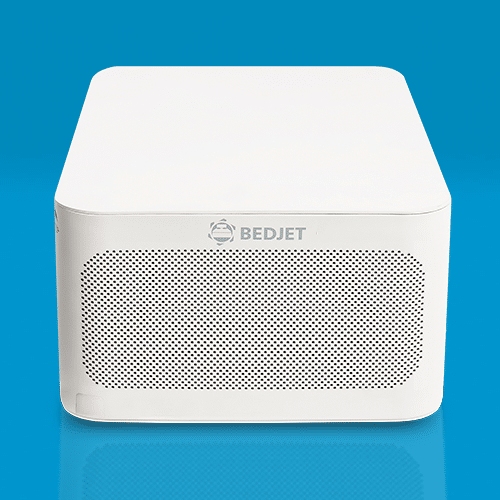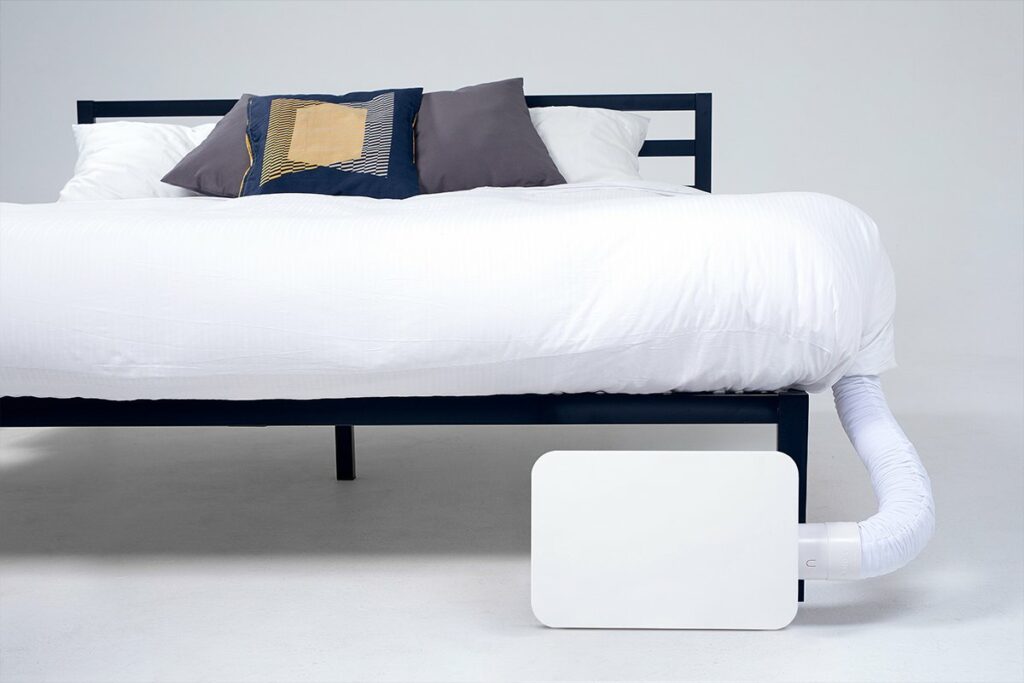
Tired of tossing and turning all night? Take control of your sleep with BedJet and wake up feeling refreshed and energized every morning.
Are you struggling to get a good night's sleep? Do you find yourself tossing and turning, unable to fall asleep or stay asleep throughout the night? If so, you're not alone. Many people struggle with sleep due to their environment. Fortunately, there are several ways to adjust your environment for better sleep. In this article, we'll explore some tips and strategies to help you get the restorative sleep you need.
How Your Environment Affects Sleep Quality
Your sleep environment plays a significant role in the quality of your sleep. Factors such as noise, light, temperature, and comfort can all have an impact on your ability to fall asleep and stay asleep.
For example, noise can be a significant disruptor of sleep. Even low-level noise can prevent you from getting the rest you need. Similarly, light can affect your body's circadian rhythm, making it difficult to fall asleep and stay asleep. The temperature of your room can also be a significant factor in sleep quality. If your room is too hot or too cold, it can make it difficult to get comfortable and fall asleep. Finally, discomfort caused by your mattress or pillows can also prevent you from getting the quality sleep your body needs.
Adjusting Your Environment for Better Sleep
- Environment affects sleep quality.
- Assess and adjust noise levels, lighting, temperature, mattress, pillows, and distractions.
- Establish a relaxing bedtime routine and consider other factors such as diet, exercise, and stress management.
Assessing Your Sleep Environment
Before you can adjust your sleep environment, you need to assess it. Here are some factors to consider when evaluating your sleep environment:
Noise Levels in the Bedroom
Start by evaluating the noise levels in your bedroom. Are there any sources of noise that are disrupting your sleep? If so, consider ways to reduce the noise levels, such as using earplugs or investing in soundproofing.
Lighting Situation
Evaluate the lighting situation in your bedroom. Is there any light that is preventing you from falling asleep or waking you up during the night? For example, streetlights or a bright alarm clock can be disruptive. Consider ways to block out light, such as using blackout curtains or wearing an eye mask.
Ideal Temperature
Temperature can also impact your sleep quality. Determine the ideal temperature for your bedroom. Most people sleep best in a cool room, around 60-67 degrees Fahrenheit. Adjust your thermostat accordingly to create an ideal sleep environment.
Comfort of Mattress and Pillows
The comfort of your mattress and pillows is also essential for a good night's sleep. Make sure your mattress and pillows are comfortable and supportive. If they're not, consider investing in new ones.
Eliminating Distractions
Finally, identify any distractions in your bedroom. Do you have a TV, computer, or phone in your room? If so, consider removing them. Clutter can also be a distraction, so consider ways to keep your room tidy and organized.
| Sleep Environment Factor | Assessment | Adjustment |
|---|---|---|
| Noise Levels | Evaluate sources of noise in the bedroom | Use earplugs or invest in soundproofing; White noise machines |
| Lighting | Evaluate if any light is preventing sleep | Use blackout curtains or an eye mask; Move bed away from sources of light |
| Temperature | Determine ideal temperature for the bedroom | Use a fan, air conditioning or heating to adjust temperature |
| Comfort of Mattress and Pillows | Evaluate if mattress and pillows are comfortable and supportive | Invest in comfortable and supportive mattress and pillows; Consider memory foam mattress or pillows |
| Distractions | Identify distractions in the bedroom | Remove electronics and clutter; Keep bedroom tidy and organized |
Adjusting Your Sleep Environment
Once you've assessed your sleep environment, it's time to make adjustments. Here are some ways to adjust your sleep environment for better sleep:
Reducing Noise Levels
If noise levels are a problem, consider using earplugs or investing in soundproofing. White noise machines can also be helpful in drowning out disruptive noise.
Blocking Out Light
To block out light, use blackout curtains or an eye mask. You can also try moving your bed away from any sources of light.
Adjusting the Temperature
Adjust the temperature of your room to create an ideal sleep environment. Use a fan, air conditioning, or heating to get the temperature just right.
Investing in a Comfortable Mattress and Pillows
Invest in a comfortable mattress and pillows. Make sure they're supportive and comfortable. Consider a memory foam mattress or pillows if you need extra support.
Eliminating Distractions
Eliminate distractions in your bedroom. Remove electronics and clutter. Keep your bedroom tidy and organized.
Establishing a Relaxing Bedtime Routine
In addition to adjusting your sleep environment, it's essential to establish a relaxing bedtime routine. Here are some tips for creating a relaxing bedtime routine:
Establishing a Sleep Schedule
Establish a sleep schedule and stick to it. Go to bed and wake up at the same time every day, even on weekends.
Practicing Relaxation Techniques
Practice relaxation techniques before bed, such as deep breathing, meditation, or yoga. These techniques can help calm your mind and prepare you for sleep.
Avoiding Stimulating Activities
Avoid stimulating activities before bed, such as exercise, caffeine, or electronics. Instead, try reading a book or taking a warm bath.
Using Aromatherapy to Promote Relaxation
Use aromatherapy to promote relaxation. Lavender, chamomile, and jasmine are all scents that can help you relax and fall asleep.
Other Factors to Consider
In addition to adjusting your sleep environment and establishing a relaxing bedtime routine, there are other factors to consider for better sleep. Here are a few:
Case Study: How Adjusting My Sleep Environment Improved My Sleep Quality
Before adjusting my sleep environment, I struggled with getting quality sleep. I would toss and turn throughout the night, wake up feeling groggy and tired, and often found myself relying on caffeine to get through the day.
After reading about the impact of environment on sleep quality, I decided to make some changes. First, I evaluated the noise levels in my bedroom and invested in a white noise machine to block out any distractions. I also adjusted the temperature to my preferred setting, invested in a comfortable mattress and pillows, and eliminated any sources of light.
In addition to adjusting my sleep environment, I created a relaxing bedtime routine. I established a sleep schedule and practiced relaxation techniques such as meditation and deep breathing. I also avoided any stimulating activities or screens before bed and used lavender essential oil in a diffuser to promote relaxation.
As a result of these changes, I noticed a significant improvement in my sleep quality. I was able to fall asleep faster, stay asleep throughout the night, and wake up feeling refreshed. I no longer relied on caffeine to get through the day and felt more productive and focused.
By prioritizing my sleep and adjusting my sleep environment, I was able to improve my overall health and well-being.
The Impact of Caffeine and Alcohol on Sleep Quality
Caffeine and alcohol can both impact sleep quality. Avoid consuming caffeine or alcohol before bed, as they can disrupt your sleep.
The Role of Diet and Exercise in Promoting Better Sleep
Diet and exercise can also impact sleep quality. Eat a healthy diet and exercise regularly to promote better sleep.
The Importance of Managing Stress
Finally, managing stress is essential for better sleep. Practice stress-reducing techniques, such as mindfulness or exercise, to help you manage stress and get better sleep.
Conclusion
Adjusting your environment for better sleep can make a significant difference in your sleep quality and overall health and well-being. By assessing your sleep environment, making adjustments, and establishing a relaxing bedtime routine, you can improve your sleep quality and wake up feeling refreshed and rejuvenated. Don't be afraid to experiment with different adjustments to find what works best for you. Remember, sleep is essential for overall health and wellness.
Q & A
Who benefits from adjusting their environment for better sleep?
Anyone who struggles with falling or staying asleep.
What changes can I make to my environment for better sleep?
Adjust lighting, temperature, noise, and comfort of bedding.
How long does it take to see results from adjusting my sleep environment?
Results can be seen immediately, but may take a few days to fully adjust.
What if I can't make adjustments to my sleep environment?
Try using earplugs, an eye mask, or a white noise machine.
How do I know if my environment is optimized for sleep?
If you consistently fall asleep easily and stay asleep all night.
What if I still can't sleep after adjusting my environment?
Consult with a medical professional to rule out any underlying health issues.
The author of “Creating a Sleep Haven” has extensive experience in the field of sleep and its impact on overall health and well-being. With a background in psychology and a focus on sleep disorders, the author has conducted research on the effects of environment on sleep quality and has published several studies on the subject.
The author's work has been featured in numerous academic journals and has been presented at several international conferences. Additionally, the author has worked with patients suffering from various sleep disorders, providing guidance on how to improve their sleep environment and adopt healthy sleep habits.
The author's expertise in the field has led to the development of practical strategies for creating a sleep-friendly environment and establishing a healthy sleep routine. The author emphasizes the importance of identifying and eliminating distractions, adjusting lighting and temperature, and investing in comfortable bedding.
Through the author's guidance, readers can expect to gain a deeper understanding of the factors influencing sleep quality and learn practical ways to create a relaxing and rejuvenating sleep environment.

Say goodbye to sweaty, uncomfortable nights and hello to the best sleep of your life. Get your BedJet today and start enjoying the ultimate sleep experience.



